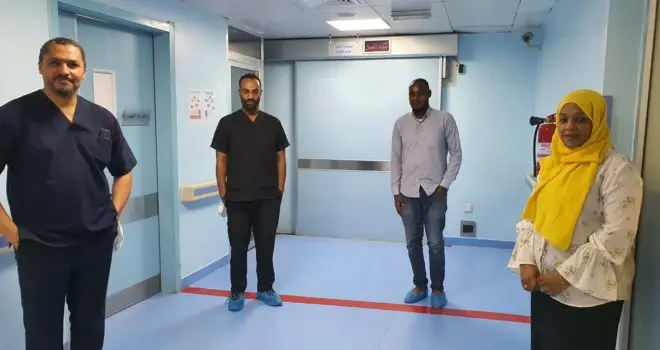
This profile piece is part of a series by the World Heart Federation. Since the start of the COVID-19 pandemic, concerns have been echoed about the health risks, preparedness, and resources in low- and middle-income countries where medical systems might be under strain and communities lack adequate access to medical treatment and coverage. WHF has the special opportunity to connect with diverse parts of its network and bring perspectives to a global health crisis that is affecting so many, especially the elderly and those already suffering from illnesses such as cardiovascular disease.
Professor Liesl Zühlke, Pediatric Cardiologist in Cape Town shares her perspective from South Africa.
Overview – coping province by province
At the time of writing, we are approaching 200,000 positive cases and 3,000 deaths, with variability across South Africa’s nine provinces. The three most affected provinces account for more than 80% of cases in the country: the Western Cape which is home to Cape Town, Gauteng which is home to Johannesburg, and the Eastern Cape, with its largest city of Port Elizabeth.
Cases were greater at first in the Western Cape but cases in Gauteng province are now rapidly escalating and are likely to surpass those in the other provinces. A combination of imported cases, high-travel zones, and populous areas explain the pattern early in the outbreak: the first cases were inbound travelers through Johannesburg International Airport and Cape Town International Airport; in addition, the Eastern Cape and Gauteng are among the most densely populated provinces. By contrast, the Northern Cape province, which is between the Western Cape and Namibia, is a very sparsely populated province and currently experiencing 0.3% of the entire national caseload.
While the Western Cape appears set to handle the load, there is real concern that the less-resourced Eastern Cape, already a poor province with less robust health systems, will struggle if the numbers there explode. The general belief is that the disease plateau will be lower but longer than expected and that it is still about three to four weeks away. The unfortunate reality here, as elsewhere, is that many health workers have contracted the disease themselves and even died of it.
Working with the numbers
There is also a divergence between public and private health practice, with the number of beds in the public service being generally higher. The Western Cape is coping with the numbers of patients admitted to hospital and though it will soon attain full capacity, there is still room for new beds. At the University of Cape Town Hospital where I work, new beds are being installed regularly. Not only is there a new ward every week, there are also improvised facilities: for example, the hospital convention center has been converted into an 880-bed intermediary hospital and there is potential for converting other facilities for medical use—difficult but doable.
The quality of data collection has meant that we are always aware of developments and changes and this is an indispensable tool in a time of crisis. We are continually preparing based on the numbers so we know what kind of flow to expect and the resources we need to have in place, while remaining flexible. It is quite interesting the way we are learning and adjusting to evolving data on the spot: It could be that last week we said we needed a particular new hospital and then once in operation, we would say we probably need a second one like it, only to find that based on new numbers, we probably don’t need a second one but we need the first one to stay open longer. It depends on what the numbers say.
Where are the non-COVID patients?
As global case figures showed, many countries saw a decline in numbers of patients seeking routine or emergency care for other critical diseases including heart disease. The exact decline in South Africa is to be determined but anecdotally, we have seen much less of the usual cardiac presentations than we would usually have, both in and out and of pediatric medicine. Cardiac patients and other patients probably reason that others need more urgent care if they are struck by COVID-19 in a system under strain, or they simply stay away for fear of contracting the disease by dint of being in a medical setting.
Every non-COVID patient is still affected by the pandemic because there are fewer nurses, fewer beds, less surgical capacity and so on. For example, our waiting list of patients for surgery has increased from 100 to more than 160 and less critical interventions are also put on hold. Everybody is doing their best to stay healthy or to not need radical health interventions.
Health systems and fixing the ‘fault lines’
The national Department of Health has been really good about the messaging. It is out everywhere and the public communication campaigns have been very strong, with repeated recommendations and measures about hygiene, social distancing, and the wearing of masks (in shops and on public transport) on every radio station, television channels and other platforms. I have not seen my immediate family for four months, apart from my husband and children. We experienced a long, hard lockdown, clearly with economic implications, with many industries closing and many losing their jobs. Measures have been introduced such as direct cash transfers to households and businesses through a $26 billion (€23 billion) recovery package.
The current health crisis has indeed exposed many ‘fault lines’ that we will need to address in the health system in the health system. One upside is the many open debates taking place around the interconnections between health and economy, the importance of social cohesion, the elimination of gender-based violence, and the ways in which alcohol and cigarettes affect basic health. More than ever, we have an opportunity to emphasize that strong public health is key to a thriving society, not least of which entails appreciating health service workers.
Critical impacts beyond the hospital ward
Densely populated areas and urban areas reflect higher incidence of disease but the disease hits hard in rural areas and among the urban poor by affecting the security of day to day life in already difficult conditions. The knock-on effect of people not working and therefore not earning income to procure basic supplies, food and even to access government assistance is very real.
COVID-19 affects mostly adults and yet, even when children are not directly affected, they still bear a burden. They are being consistently affected when parents are unable to work because they are ill or because they have lost their sources of income, and risk being deprived of food and nutrition and attending school.
Pulling together, from beer to soup
We lost a healthcare worker who was not only a solid children’s advocate and researcher but active on the specific campaign and advocacy work on this pandemic. Against this cruel backdrop, it is heartening to see the extent to which people have been coming together, volunteering their services to support in various ways and offering inter-community assistance. At the hospital itself, pediatricians in training formed a group to collect toys, books and food packages for staff patients who had to stay at home. Community Action Networks (CAN) have sprung up all across the Western Cape to fill gaps for basic supplies.
A chef friend of mine is now part of an entire group of chefs in his town, cooking for the community daily. A local microbrewery is making soup instead — 5000 litres of it every day. People donate the equivalent of a cup of coffee or lovely latte which helps purchase the ingredients. And schools stepped up to the challenge too: in their ‘matric’ or final year, instead of holding their matric dance – similar to “prom” in other countries – the funds for the event went instead to running a food kitchen for those most in need. And there are so many stories such as these playing out across the globe and often here in South Africa, giving us the boost we need to carry on in these tough times, and reminding us of what it really means to care.
University of Cape Town has published resources both for parents and children going through the pandemic, with stories such as ‘Super 3 and the Invisible Monster’ to the ‘Coronavirus – A Book for Children’ and ‘How to Support Children (and Yourself) during the COVID-19 Outbreak.’



